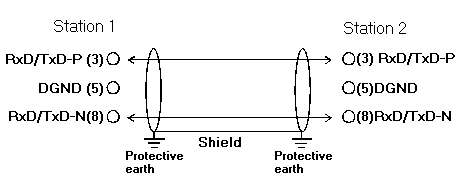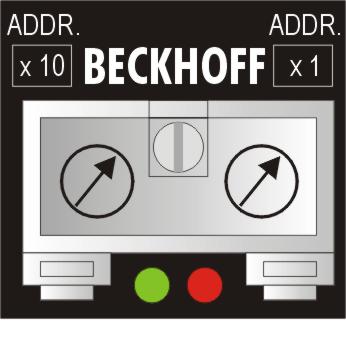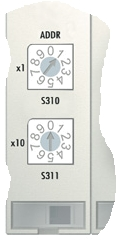Plug connectors, cables and switches
The physics of the transmission
Physical aspects of the data transmission are defined in the PROFIBUS standard. See PROFIBUS layer 1 (physical layer).
The types of area where a fieldbus system can be used is largely determined by the choice of the transmission medium and the physical bus interface. In addition to the requirements for transmission security, the expense and work involved in acquiring and installing the bus cable is of crucial significance. The PROFIBUS standard therefore allows for a variety of implementations of the transmission technology while retaining a uniform bus protocol.
Cable-based transmission: This version, which accords with the American EIA RS-485 standard, was specified as a basic version for applications in production engineering, building management and drive technology. A twisted copper cable with one pair of conductors is used. Depending on the intended application area (EMC aspects should be considered) the shielding may be omitted.
Cable-related faults
Two types of conductor are available, with differing maximum conductor lengths; see the "RS485" table. The plug connector assignment and the wiring are shown in the diagram below. Note the special requirements on the data cable for baud rates greater than 1.5 Mbaud. The correct cable is a basic requirement for correct operation of the bus system. If a "simple" 1.5 Mbaud cable is used, reflections and excessive attenuation can lead to some surprising phenomena. This could, for example be that some station is not connected, but when the neighboring station is unplugged the connection appears again. Or there may be transmission errors when a specific bit pattern is transmitted. The result of this can be that when the equipment is not operating, PROFIBUS works without faults, but that there are apparently random bus errors after start-up. Reducing the baud rate (< 93.75 kbaud) corrects this faulty behavior.
If reducing the baud rate does not correct the error, then in many cases this can indicate a wiring fault. The two data lines maybe crossed over at one or more connectors, the termination resistors may not be switched on, or they may be active at the wrong locations.
 | Preassembled cable from Beckhoff Installation is made a great deal more straightforward if preassembled cables from Beckhoff are used. Wiring errors are avoided, and commissioning is more rapidly completed. The range includes fieldbus cables, power supply cables, sensor cables and accessories such as termination resistors and T-pieces. Connectors and cables for field assembly are nevertheless also available. |
PROFIBUS connection of the Fieldbus Box modules
The M12 socket is inverse-coded and has 5 contact pins. Pin 1 transfers 5 VDC, pin 3 transfers GND for the active termination resistor. These must never be misused for other functions, as this can lead to destruction of the device. Pins 2 and 4 transfer the PROFIBUS signals. These must never be swapped over, as this will prevent communication. Pin 5 transfers the shield, which is capacitively connected to the base of the Fieldbus Box.
PROFIBUS socket pin assignment

PROFIBUS wire colors
|
PROFIBUS line |
M12 |
D sub |
|---|---|---|
|
B red |
Pin 4 |
Pin 3 |
|
A green |
Pin 2 |
Pin 8 |
RS485 - Fundamental properties
|
RS-485 transmission according to the PROFIBUS standard | |
|---|---|
|
Network topology |
Linear bus, active bus terminator at both ends, stubs are possible. |
|
Medium |
Screened twisted cable, shielding may be omitted, depending upon the environmental conditions (EMC). |
|
Number of stations |
32 stations in each segment with no repeater. Can be extended to 127 stations with repeater |
|
Max. bus length without repeater |
100 m at 12 Mbit/s |
|
Max. bus length with repeater |
Line amplifiers (repeaters) can increase the bus length to the order of 10 km. The number of repeaters possible is at least 3, and, depending on the manufacturer, may be up to 10 |
|
Data transfer rate |
9.6, 19.2, 93.75, 187.5, 500, 1500 kbit/s, up to 12 Mbit/s, infinitely variable |
|
Connector |
9-pin D sub connector for IP20 |
Cabling for PROFIBUS-DP and PROFIBUS_FMS

 | Termination resistors In systems with more than two stations all devices are wired in parallel. The PROFIBUS cable must be terminated with resistances at both ends, in order to avoid reflections and associated transfer problems. |
Addressing
Setting of station addresses
The PROFIBUS address must be set using the two rotary selection switches behind the transparent cover. The default setting is 11. Any address is permitted, but each address may only be used once within the network. The address can be modified when the Fieldbus Box (Bus Coupler) is switched off. Release the cover (Fieldbus Box only) and set the switches to the required position using a screwdriver. Make sure that the switches engage properly. The change in address is active as soon as the device is switched on.
Fieldbus Box address
The switch on the left represents the tens, while that on the right represents the units.

Bus Coupler address
The lower switch S311 represents the tens, while the upper switch S310 represents the unit.
